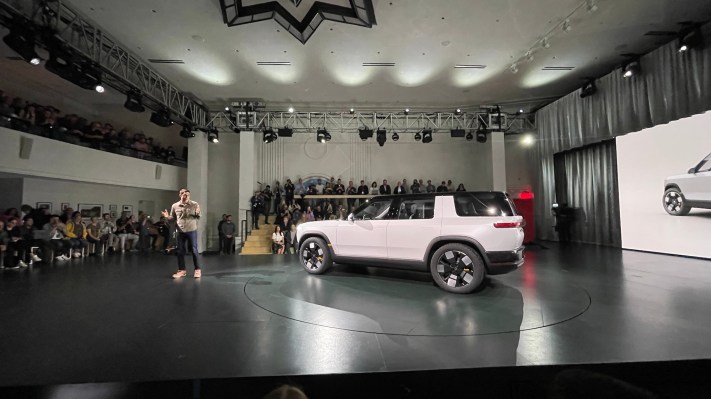
As customers, VIP guests and media milled into the Rivian South Coast Theater in Laguna Beach on Thursday — the Pacific Ocean crashing on the beach just a few hundred feet away — a mix of hope and excitement rippled through the arena. The occasion was the unveiling of the Rivian R2, a smaller and more affordable all-electric SUV, and a vital vehicle for the EV upstart hoping to show the world it’s here to stay.
Early supporters of Rivian, friends and founder RJ Scaringe’s young family filled the seats of the renovated theater. The air was filled with conversations about their Rivian vehicles, exclamations and congratulations, hugs and handshakes, and discussions of their hopes for the R2.
When the Rivian R2 did arrive — it did not come alone. Scaringe had two “one more thing moments,” showing off two more electric vehicles under the next-generation R3 platform along with updates on production and hints about accessories that will match up with the active lifestyle branding Rivian has become famous for.
The R2, a two-row all-electric SUV that will have an estimated range of 300 miles and a base price of $45,000, was the main event. The encore was the smaller R3 and the R3x performance, a compact hatchback style EV with sporty vibes.
The R2, which customers can reserve starting today, will come in several powertrains, a single motor, dual motor and tri-motor version. Some of the biggest applause came when Scaringe announced that the company was moving up production of the R2 to the half first of 2026. Notably, he said that the R2 would initially be produced at the automaker’s Normal, Illinois factory — a change from the company’s original plan to produce the R2 at a $5 billion factory near Atlanta, Georgia, that is just now under construction.
Today, Rivian produces four vehicles at its sole factory in Normal, Illinois: its two consumer vehicles, the R1T truck and R1S SUV, and two versions of its commercial van.
Scaringe called the company’s first EVs, the R1S and R1T, the company’s handshake to the world. The R2 and the R3, which sent the crowd abuzz — their hoots and howls echoing through the theater — was clearly designed as the full embrace. Scaringe, gleaming on stage as he awaited the R3 to roll out on stage, seemed determined to send a message: Rivian has arrived.
The all-electric vehicle is still two years away from production. And when it does, the R2 will face an evolved EV market with more choices and players, many of which are expected to fall into the same more affordable category. Scaringe and the design team have leaned into the R2 styling and accessories — the trademarks of its R1S and R1T.
Rivian promises the R2 will be something wholly different. It won’t just be lower cost, making it more accessible to a wider customer base, and produced at volume. The R2 will also reflect manufacturing maturity — a vehicle that loaded with efficiencies that will finally lead Rivian down the path to profitability.
Rivian loses money on every R1S and R1T it makes, to the tune of $43,372 per unit delivered in fourth quarter of 2023, according to regulatory filings. So finding efficiencies to reduce manufacturing costs as well as better deals with suppliers is critical to Rivian’s aim to make money on each vehicle it sells.

